136 scholarly books by Dartmouth College Press and 18
have author last names that start with B
136 scholarly books by Dartmouth College Press and 18
136 scholarly books by Dartmouth College Press
18 have author last names that start with B have author last names that start with B
18 have author last names that start with B have author last names that start with B

The Racial Imaginary of the Cold War Kitchen
From Sokol’niki Park to Chicago’s South Side
Kate A. Baldwin
Dartmouth College Press, 2016
This book demonstrates the ways in which the kitchen—the centerpiece of domesticity and consumerism—was deployed as a recurring motif in the ideological and propaganda battles of the Cold War. Beginning with the famous Nixon–Khrushchev kitchen debate, Baldwin shows how Nixon turned the kitchen into a space of exception, while contemporary writers, artists, and activists depicted it as a site of cultural resistance. Focusing on a wide variety of literature and media from the United States and the Soviet Union, Baldwin reveals how the binary logic at work in Nixon’s discourse—setting U.S. freedom against Soviet totalitarianism—erased the histories of slavery, gender subordination, colonialism, and racial genocide. The Racial Imaginary of the Cold War Kitchen treats the kitchen as symptomatic of these erasures, connecting issues of race, gender, and social difference across national boundaries. This rich and rewarding study—embracing the literature, film, and photography of the era—will appeal to a broad spectrum of scholars.
[more]
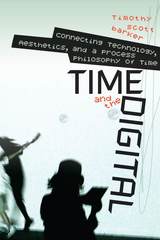
Time and the Digital
Connecting Technology, Aesthetics, and a Process Philosophy of Time
Timothy Scott Barker
Dartmouth College Press, 2012
Eschewing the traditional focus on object/viewer spatial relationships, Timothy Scott Barker’s Time and the Digital stresses the role of the temporal in digital art and media. The connectivity of contemporary digital interfaces has not only expanded the relationships between once separate spaces but has increased the complexity of the temporal in nearly unimagined ways. Invoking the process philosophy of Whitehead and Deleuze, Barker strives for nothing less than a new philosophy of time in digital encounters, aesthetics, and interactivity. Of interest to scholars in the fields of art and media theory and philosophy of technology, as well as new media artists, this study contributes to an understanding of the new temporal experiences emergent in our interactions with digital technologies.
[more]

Hijacked Brains
The Experience and Science of Chronic Addiction
Henrietta Robin Barnes
Dartmouth College Press, 2015
This book, written from the perspective of a practicing primary care physician, interweaves patients’ stories with fascinating new brain research to show how addictive drugs overtake basic brain functions and transform them to create a chronic illness that is very difficult to treat. The idea that drug and alcohol addiction are chronic illnesses and not character flaws is not news—this notion has been around for many years. What Hijacked Brains offers is context and personal stories that demonstrate this point in a very accessible package. Dr. Barnes explores how the healthy brain works, how addictive drugs flood basic reward pathways, and what it feels like to grapple with addiction. She discusses how, for individuals, the combination of genetic and environmental factors determines both vulnerability for addiction and the resilience necessary for recovery. Finally, she shows how American culture, with its emphasis on freewill and individualism, tends to blame the addict for bad choices and personal weakness, thereby impeding political and/or health-related efforts to get the addict what she needs to recover.
[more]
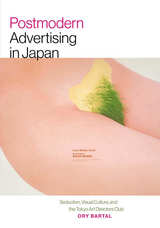
Postmodern Advertising in Japan
Seduction, Visual Culture, and the Tokyo Art Directors Club
Ory Bartal
Dartmouth College Press, 2015
In a study driven by stunning images of Japanese advertisements and the artworks they quote from, Ory Bartal offers a first-of-its-kind interpretation of the “postmodern” genre of advertising in Japan, which both shaped and reflected the new consumer-driven culture that arose during the bubble era of the 1980s and 1990s. Through a fascinating tale of art directors and their works and influences, Bartal shows how this postmodern visual language, like postmodernism in other streams, is distinguished by its mélange of styles, blurring of boundaries between art and design, and reliance on visual and textual quotations from sources past and present, domestic and foreign. Although this advertising culture partakes of global trends, Bartal draws attention to the varied local artistic sensibilities, structures of thought, and underlying practices, challenging the often-simplistic characterization of “Japaneseness” as being rooted in a Zen tradition of aesthetic indirectness and ambiguity. Combining multilingual scholarship with a wealth of information gleaned through years of personal interviews with the principals involved, this is a truly original contribution to the discussion of Japanese art and advertising as well as an insightful reading of more general issues in the study of visual culture and media.
[more]
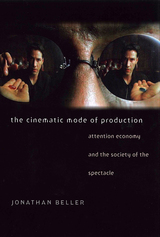
The Cinematic Mode of Production
Attention Economy and the Society of the Spectacle
Jonathan Beller
Dartmouth College Press, 2006
“Cinema brings the industrial revolution to the eye,” writes Jonathan Beller, “and engages spectators in increasingly dematerialized processes of social production.” In his groundbreaking critical study, cinema is the paradigmatic example of how the act of looking has been construed by capital as “productive labor.” Through an examination of cinema over the course of the twentieth century, Beller establishes on both theoretical and historical grounds the process of the emergent capitalization of perception. This process, he says, underpins the current global economy. By exploring a set of films made since the late 1920s, Beller argues that, through cinema, capital first posits and then presupposes looking as a value-productive activity. He argues that cinema, as the first crystallization of a new order of media, is itself an abstraction of assembly-line processes, and that the contemporary image is a politico-economic interface between the body and capitalized social machinery. Where factory workers first performed sequenced physical operations on moving objects in order to produce a commodity, in the cinema, spectators perform sequenced visual operations on moving montage fragments to produce an image. Beller develops his argument by highlighting various innovations and film texts of the past century. These innovations include concepts and practices from the revolutionary Soviet cinema, behaviorism, Taylorism, psychoanalysis, and contemporary Hollywood film. He thus develops an analysis of what amounts to the global industrialization of perception that today informs not only the specific social functions of new media, but also sustains a violent and hierarchical global society.
[more]

Native Land Talk
Indigenous and Arrivant Rights Theories
Yael Ben-zvi
Dartmouth College Press, 2018
Histories of rights have too often marginalized Native Americans and African Americans. Addressing this lacuna, Native Land Talk expands our understanding of freedom by examining rights theories that Indigenous and African-descended peoples articulated in the eighteenth and nineteenth centuries. As settlers began to distrust the entitlements that the English used to justify their rule, the colonized and the enslaved formulated coherent logics of freedom and belonging. By anchoring rights in nativity, they countered settlers’ attempts to dispossess and disenfranchise them. Drawing on a plethora of texts, including petitions, letters, newspapers, and official records, Yael Ben-zvi analyzes nativity’s unsettling potentials and its discursive and geopolitical implications. She shows how rights were constructed in relation to American, African, and English spaces, and explains the obstacles to historic solidarity between Native American and African American struggles.
[more]
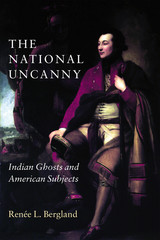
The National Uncanny
Indian Ghosts and American Subjects
Renée L. Bergland
Dartmouth College Press, 2000
Although spectral Indians appear with startling frequency in US literary works, until now the implications of describing them as ghosts have not been thoroughly investigated. In the first years of nationhood, Philip Freneau and Sarah Wentworth Morton peopled their works with Indian phantoms, as did Charles Brocken Brown, Washington Irving, Samuel Woodworth, Lydia Maria Child, James Fenimore Cooper, William Apess, Nathaniel Hawthorne, and others who followed. During the late 19th and early 20th centuries, Native American ghosts figured prominently in speeches attributed to Chief Seattle, Black Elk, and Kicking Bear. Today, Stephen King and Leslie Marmon Silko plot best-selling novels around ghostly Indians and haunted Indian burial grounds. Renée L. Bergland argues that representing Indians as ghosts internalizes them as ghostly figures within the white imagination. Spectralization allows white Americans to construct a concept of American nationhood haunted by Native Americans, in which Indians become sharers in an idealized national imagination. However, the problems of spectralization are clear, since the discourse questions the very nationalism it constructs. Indians who are transformed into ghosts cannot be buried or evaded, and the specter of their forced disappearance haunts the American imagination. Indian ghosts personify national guilt and horror, as well as national pride and pleasure. Bergland tells the story of a terrifying and triumphant American aesthetic that repeatedly transforms horror into glory, national dishonor into national pride.
[more]

American Paper Mills, 1690–1832
A Directory of the Paper Trade with Notes on Products, Watermarks, Distribution Methods, and Manufacturing Techniques
John Bidwell
Dartmouth College Press, 2013
Unprecedented in size and scope, this directory describes more than 500 paper mills on the basis of census records, archival sources, local histories, and watermark evidence. It traces economic developments and technological changes in the American paper trade from the colonial period to the industrial era, with special reference to its close connections with the printing business, which depended on local sources of supply for newsprint, book paper, and plate paper for engraved illustrations. Newly discovered and reattributed watermarks make it possible to identify these products and provide a more reliable means of dating and localizing works on paper. This fully documented survey of paper mills also contains biographical information about members of the trade and a succinct history of papermaking in America with essays on manufacturing methods, mechanization, business practices, and distribution networks. Among the illustrations in this volume are hitherto unrecorded woodcut and engraved views of manufactories, used in the packaging art of that period.
[more]

The Imaginary and Its Worlds
American Studies after the Transnational Turn
Laura Bieger
Dartmouth College Press, 2013
The Imaginary and Its Worlds collects essays that boldly rethink the imaginary as a key concept for cultural criticism. Addressing both the emergence and the reproduction of the social, the imaginary is ideally suited to chart the consequences of the transnational turn in American studies. Leading scholars in the field from the United States and Europe address the literary, social, and political dimensions of the imaginary, providing a methodological and theoretical groundwork for American studies scholarship in the transnational era and opening new arenas for conceptualizing formations of imaginary belonging and subjectivity. This important state-of-the-field collection will appeal to a broad constituency of humanists working to overcome methodological nationalism. The Imaginary and Its Worlds: An Introduction • LITERARY IMAGINARIES • Imagining Cultures: The Transnational Imaginary in Postrace America - Ramón Saldívar • The Necessary Fragmentation of the (U.S.) Literary-Cultural Imaginary - Lawrence Buell • Imaginaries of American Modernism - Heinz Ickstadt • SOCIAL IMAGINARIES • William James versus Charles Taylor: Philosophy of Religion and the Confines of the Social and Cultural Imaginaries - Herwig Friedl • The Shaping of We-Group Identities in the African American Community: A Perspective of Figurational Sociology on the Cultural Imaginary - Christa Buschendorf • Russia’s Californio Romance: The Other Shores of Whitman’s Pacific - Lene Johannessen • Form Games: Staging Life in the Systems Epoch - Mark Seltzer • POLITICAL IMAGINARIES • Real Toads - Walter Benn Michaels • Obama Unwound: The Romanticism of Victory and the Defeat of Compromise - Christopher Newfield • Barack Obama’s Orphic Mysteries - Donald E. Pease • Coda. The Imaginary and the Second Narrative: Reading as Transfer - Winfried Fluck • Contributors • Index
[more]

Empire of Liberty
Power, Desire, and Freedom
Anthony Bogues
Dartmouth College Press, 2010
In this thoughtful and timely consideration of the nature of American power and empire, Anthony Bogues argues that America’s self-presentation as the bastion of liberty is an attempt to force upon the world a single universal truth, which has the objective of eradicating the radical imagination. Central to this project of American supremacy is the elaboration and construction of a language of power in which a form of self-government appears as the form of sovereignty. Grappling with issues of power, race, slavery, violence, and the nature of postcolonial criticism and critical theory, Bogues offers reconsiderations of the writings of W. E. B. DuBois and Frantz Fanon in order to break holes in this accepted structure of empire. At its heart this is a work of radical humanistic theory that seeks to glean from the postcolonial world and empire an alternative to its imperial form of freedom.
[more]
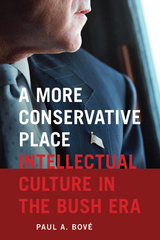
A More Conservative Place
Intellectual Culture in the Bush Era
Paul A. Bové
Dartmouth College Press, 2013
Identifying the historical antecedents of President George W. Bush’s imperial ambitions and the sources of the reactionary thought and politics that underlie them, Paul A. Bové shows how neoconservatism represents a singular danger to democracy. At the same time, he criticizes the equally disheartening inability of the academic Left to oppose neoconservatives and its tendency to mirror their views instead. Divorced from historical knowledge and intellectual rigor, the neocon mindset reflects a cultural and historical amnesia that feeds on ignorance and conformity. Exposing the threats to national survival inherent in the alliance of right-wing politics and academic tribalism, Bové emphasizes the need to reconnect with the powers of imagination and the complexity of human historical experience. With urgency and passion, Bové shows how the neocons have succeeded in cowing or coopting academic intellectuals and how language has been used and abused for the maintenance and extension of an undemocratic regime.
[more]
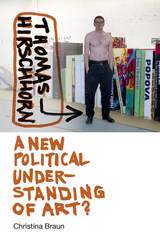
Thomas Hirschhorn
A New Political Understanding of Art?
Christina Braun
Dartmouth College Press, 2018
Thomas Hirschhorn, a leading installation artist whose work is owned and exhibited by modern art museums throughout Europe and the United States, is known for compelling, often site-specific and interactive environments tackling issues of critical theory, global politics, and consumerism. His work initially engages the viewer through sheer superabundance. Combining found images and texts, bound up in handcrafted constructions of cardboard, foil, and packing tape, the artworks reflect the intellectual scavenging and sensory overload that characterize our own attempts to grapple with the excess of information in daily life. Christina Braun, the first to compile and systematically analyze the extensive source material on this artist’s theoretical principles, sheds light on the complicated yet constitutive relations between Hirschhorn’s work and theory. Her study, now translated into English, makes a major contribution to the study of contemporary art.
[more]
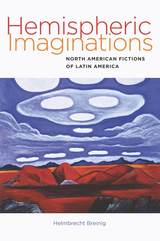
Hemispheric Imaginations
North American Fictions of Latin America
Helmbrecht Breinig
Dartmouth College Press, 2016
What image of Latin America have North American fiction writers created, found, or echoed, and how has the prevailing discourse about the region shaped their work? How have their writings contributed to the discursive construction of our southern neighbors, and how has the literature undermined this construction and added layers of complexity that subvert any approach based on stereotypes? Combining American Studies, Canadian Studies, Latin American Studies, and Cultural Theory, Breinig relies on long scholarly experience to answer these and other questions. Hemispheric Imaginations, an ambitious interdisciplinary study of literary representations of Latin America as encounters with the other, is among the most extensive such studies to date. It will appeal to a broad range of scholars of American Studies.
[more]

Conservancy
The Land Trust Movement in America
Richard Brewer
Dartmouth College Press, 2004
Land trusts, or conservancies, protect land by owning it. Although many people are aware of a few large land trusts—The Nature Conservancy and the Trust for Public Land, for instance—there are now close to 1,300 local trusts, with more coming into being each month. American land trusts are diverse, shaped by their missions and adapted to their local environments. Nonetheless, all land trusts are private, non-profit organizations for which the acquisition and protection of land by direct action is the primary or sole mission. Nonconfrontational and apolitical, land trusts work with willing land owners in voluntary transactions. Although land trusts are the fastest-growing and most vital part of the land conservation movement today, this model of saving land by private action has become dominant only in the past two decades. Brewer tells why the advocacy model—in which private groups try to protect land by promoting government purchase or regulation— in the 1980s was eclipsed by the burgeoning land trust movement. He gives the public a much-needed primer on what land trusts are, what they do, how they are related to one another and to other elements of the conservation and environmental movements, and their importance to conservation in the coming decades. As Brewer points out, unlike other land-saving measures, land trust accomplishments are permanent. At the end of a cooperative process between a landowner and the local land trust, the land is saved in perpetuity. Brewer’s book, the first comprehensive treatment of land trusts, combines a historical overview of the movement with more specific information on the different kinds of land trusts that exist and the problems they face. The volume also offers a "how-to" approach for persons and institutions interested in donating, selling, or buying land, discusses four major national land trusts (The Nature Conservancy, Trust for Public Land, American Farmland Trust, and Rails-to-Trails Conservancy); and gives a generous sampling of information about the activities and accomplishments of smaller, local trusts nationwide. Throughout, the book is enriched by historical narrative, analysis of successful land trusts, and information on the how and why of protecting land, as well as Brewer’s intimate knowledge of ecological systems, biodiversity, and the interconnectedness of human and non-human life forms. Conservancy is a must-read volume for people interested in land conservation—including land trust members, volunteers and supporters—as well as anyone concerned about land use and the environment.
[more]

A Dartmouth Reader
Francis Brown
Dartmouth College Press, 2002
A blend of “the light and the serious, the enlightening and the entertaining” that have formed part of the Dartmouth story since Eleazar Wheelock went into the wilderness.
[more]

Captivity and Sentiment
Cultural Exchange in American Literature, 1682–1861
Michelle Burnham
Dartmouth College Press, 2000
In a radically new interpretation and synthesis of highly popular 18th- and 19th-century genres, Michelle Burnham examines the literature of captivity, and, using Homi Bhabha's concept of interstitiality as a base, provides a valuable redescription of the ambivalent origins of the US national narrative. Stories of colonial captives, sentimental heroines, or fugitive slaves embody a "binary division between captive and captor that is based on cultural, national, or racial difference," but they also transcend these pre-existing antagonistic dichotomies by creating a new social space, and herein lies their emotional power. Beginning from a simple question on why captivity, particularly that of women, so often inspires a sentimental response, Burnham examines how these narratives elicit both sympathy and pleasure. The texts carry such great emotional impact precisely because they "traverse those very cultural, national, and racial boundaries that they seem so indelibly to inscribe. Captivity literature, like its heroines, constantly negotiates zones of contact," and crossing those borders reveals new cultural paradigms to the captive and, ultimately, the reader.
[more]

Folded Selves
Colonial New England Writing in the World System
Michelle Burnham
Dartmouth College Press, 2014
Folded Selves radically refigures traditional portraits of seventeenth-century New England literature and culture by situating colonial writing within the spatial, transnational, and economic contexts that characterized the early-modern “world system” theorized by Immanuel Wallerstein and others. Michelle Burnham rethinks American literary history and the politics of colonial dissent, and her book breaks new ground in making the economic relations of investment, credit, and trade central to this new framework for early American literary and cultural study. Transcontinental colonialism and mercantile capitalism underwrote not just the emerging world system but New World writing—suggesting that early modern literary aesthetics and the early modern economy helped to sponsor each other. Burnham locates in New England’s literature of dissent—from Ma-re Mount to the Salem witchcraft trials – a persistent use of economic language, as well as competing economies of style. The brilliance of Burnham’s study is that it exposes the transoceanic material and commercial concerns of colonial America’s literature and culture of dissent.
[more]
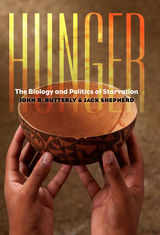
Hunger
The Biology and Politics of Starvation
John R. Butterly
Dartmouth College Press, 2010
The Universal Declaration of Human Rights, adopted by the United Nations in 1948, recognizes the individual’s right “to a standard of living adequate for the health and wellbeing of himself and his family, including food, clothing, housing, and medical care.” More than sixty years later, despite the rapid advancement of science and technology and the proliferation of humanitarian efforts, inadequate nutrition remains a major health and social problem worldwide. Food insecurity—chronic malnutrition, persistent hunger, even starvation—still afflicts more than one in seven of the world’s people. As Butterly and Shepherd show, hunger is not the result of inadequate resources and technologies; rather, its cause is a lack of political will to ensure that all people have access to the food to which they are entitled—food distributed safely, fairly, and equitably. Using a cross-disciplinary approach rooted in both medicine and social science to address this crucial issue, the authors provide in-depth coverage of the biology of human nutrition; malnutrition and associated health-related factors; political theories of inadequate nutrition and famine; historical-political behaviors that have led to famine in the past; and the current political behaviors that cause hunger and malnutrition to remain a major health problem today.
[more]
READERS
Browse our collection.
PUBLISHERS
See BiblioVault's publisher services.
STUDENT SERVICES
Files for college accessibility offices.
UChicago Accessibility Resources
home | accessibility | search | about | contact us
BiblioVault ® 2001 - 2024
The University of Chicago Press









